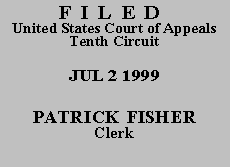

| TERRY C. CALLAWAY,
Plaintiff-Appellant, v. KENNETH S. APFEL, Commissioner, Social Security Administration, Defendant-Appellee. |
|
Plaintiff Terry C. Callaway appeals from an order of the district court affirming the Commissioner's determination that he is not entitled to Social Security benefits. We affirm.
We review the Commissioner's decision to determine whether his factual findings were supported by substantial evidence in light of the entire record and to determine whether he applied the correct legal standards. See Castellano v. Secretary of Health & Human Servs., 26 F.3d 1027, 1028 (10th Cir. 1994). "Substantial evidence is such relevant evidence as a reasonable mind might accept as adequate to support a conclusion." Id. (quotations omitted). In the course of our review, we may "neither reweigh the evidence nor substitute our judgment for that of the agency." Casias v. Secretary of Health & Human Servs., 933 F.2d 799, 800 (10th Cir. 1991).
Mr. Callaway alleged disability as of February 1993, due to a neck fracture, compressed disc, pulmonary contusion, and drug and alcohol dependence. The administrative law judge (ALJ) determined that Mr. Callaway was not disabled at step five of the five-step sequential process, see Williams v. Bowen, 844 F.2d 748, 750-52 (10th Cir. 1988), as he could perform light or sedentary work.
On appeal, Mr. Callaway contends that the ALJ erred in applying 20 C.F.R. Pt. 404, Subpt. P, App. 2 (grids), as his nonexertional impairments foreclose that use. He also argues that the hypothetical question presented to the vocational expert did not include all of his impairments.
Mr. Callaway appears to argue that the grids cannot be used whenever a claimant has any nonexertional impairments. While a nonexertional limitation may preclude use of the grids, the grids can be used if the impact of those impairments does not significantly reduce the underlying job base. See Evans v. Chater, 55 F.3d 530, 532 (10th Cir. 1995) (ability to perform "substantial majority" of work in residual functional capacity assessment suffices for purposes of grids); see also Eggleston v. Bowen, 851 F.2d 1244, 1247 (10th Cir. 1988). Here, the ALJ determined that Mr. Callaway had no significant nonexertional impairments, he could do the full range of light or sedentary work on a daily basis, and he could perform most of the jobs available at that level. See Thompson v. Sullivan, 987 F.2d 1482, 1488 (10th Cir. 1993).
Our review of the record shows substantial evidence supports this determination. Mr. Callaway takes no medication for depression. He related activities that indicate his pain does not limit him "functionally other than decreasing his walking and preventing him from lifting more than 40 pounds." App. Vol. II at 151. Mr. Callaway claims he is taking a prescription medication, Percodan, for pain. However, the record shows that he takes only over-the-counter pain medications. See id. at 40. The Percodan was prescribed by a dentist for a dental procedure. See id. at 156. While Mr. Callaway has drug and alcohol abuse problems, there is no indication he is disabled as a result. Mr. Callaway testified that he has not seen any doctors since recovery from his 1993 injury except for treatment for various nondisabling injuries.
As the ALJ found Mr. Callaway's testimony on the extent of his limitations was neither completely credible nor supported by substantial evidence, he was not required to accept all his testimony as to his physical limitations in his hypothetical. See Evans, 55 F.3d at 532 (ALJ's hypothetical questions to vocational expert "must include all (and only) those impairments borne out by the evidentiary record"). The hypothetical properly related those impairments accepted by the ALJ.
The judgment of the United States District Court for the Western District of Oklahoma is AFFIRMED.
Entered for the Court
Circuit Judge
*. This order and judgment is not binding precedent, except under the doctrines of law of the case, res judicata, and collateral estoppel. The court generally disfavors the citation of orders and judgments; nevertheless, an order and judgment may be cited under the terms and conditions of 10th Cir. R. 36.3.
**. Honorable Wesley E. Brown, Senior District Judge, United States District Court for the District of Kansas, sitting by designation.